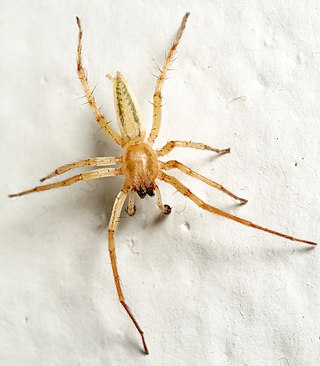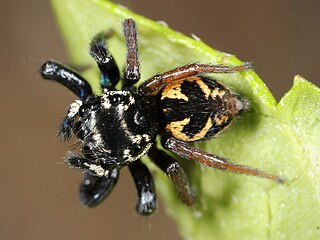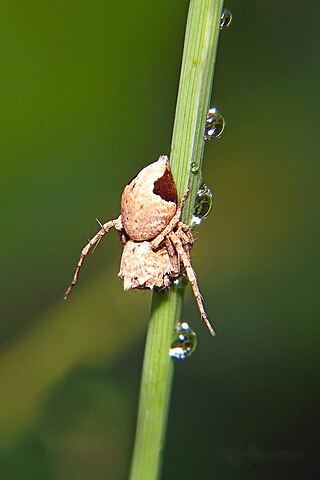
Anyphaenidae is a family of araneomorph spiders, sometimes called anyphaenid sac spiders. They are distinguished from the sac spiders of the family Clubionidae and other spiders by having the abdominal spiracle placed one third to one half of the way anterior to the spinnerets toward the epigastric furrow on the underside of the abdomen. In most spiders the spiracle is just anterior to the spinnerets. Like clubionids, anyphaenids have eight eyes arranged in two rows, conical anterior spinnerets and are wandering predators that build silken retreats, or sacs, usually on plant terminals, between leaves, under bark or under rocks. There are more than 600 species in over 50 genera worldwide.

Corythalia is a genus of jumping spiders that was first described by Carl Ludwig Koch in 1850. The genus is distributed throughout most of the Western Hemisphere.

Lycosa is a genus of wolf spiders distributed throughout most of the world. Sometimes called the "true tarantula", though not closely related to the spiders most commonly called tarantulas today, Lycosa spp. can be distinguished from common wolf spiders by their relatively large size. This genus includes the European Lycosa tarantula, which was once associated with tarantism, a dubious affliction whose symptoms included shaking, cold sweats, and a high fever, asserted to be curable only by the traditional tarantella dance. No scientific substantiation of that myth is known; the venom of Lycosa spiders is generally not harmful.

Glenognatha is a genus of long-jawed orb-weavers that was first described by Eugène Louis Simon in 1887. It was considerably revised in 2016.

Ctenus is a genus of wandering spiders first described by Charles Athanase Walckenaer in 1805. It is widely distributed, from South America through Africa to East Asia. Little is known about the toxic potential of the genus Ctenus; however, Ctenus medius has been shown to share some toxic properties with Phoneutria nigriventer, such as proteolytic, hyaluronidase and phospholipase activities, in addition to producing hyperalgesia and edema. The venom of C. medius also interferes with the complement system in concentrations in which the venom of P. nigriventer is inactive, indicating that some species in the genus may have a medically significant venom. The venom of C. medius interferes with the complement component 3 (C3) of the complement system; it affects the central factor of the cascades of the complement, and interferes with the lytic activity of this system, which causes stronger activation and consumption of the complement components. Unlike C. medius, the venom of P. nigriventer does not interfere with lytic activity.

Trachelas is a genus of araneomorph spiders originally placed with the Trachelidae, and later moved to the Corinnidae.
Chrysometa is a genus of long-jawed orb-weavers that was first described by Eugène Louis Simon in 1894. It is a senior synonym of Capichameta.

Hamataliwa is a genus of lynx spiders that was first described by Eugen von Keyserling in 1887.

Grammonota is a genus of dwarf spiders that was first described by James Henry Emerton in 1882.

Wulfila is a genus of ghost spiders first described by O. Pickard-Cambridge in 1895. They are easily recognized by their pale white elongated legs.










